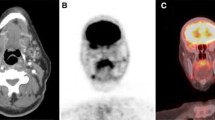Abstract.
Early diagnosis of metastases of medullary thyroid carcinoma (MTC) provides the optimal condition for curative outcome. The aim of this study was to appraise the detection of metastases in patients with recurrent MTC using [111In-DTPA-d-Phe1]-pentetreotide and pentavalent technetium-99m dimercaptosuccinic acid [99mTc(V)-DMSA] in comparison with histopathological findings. Eighteen MTC patients with persistently elevated tumour marker (calcitonin, carcinoembryonic antigen) levels underwent somatostatin receptor scintigraphy using [111In-DTPA-d-Phe1]-pentetreotide (222 MBq) with early (4 h after injection) and delayed (24 h) whole-body scans and single-photon emission tomography (SPET) imaging. Metabolic whole-body and SPET imaging using 500 MBq 99mTc(V)-DMSA was performed 4 h after injection. Metabolic and receptor imaging revealed 51 sites of focal accumulation in the 18 patients investigated. Comparison with histological findings revealed that metabolic and receptor imaging had a sensitivity of 84% for the diagnosis of MTC. Using [111In-DTPA-d-Phe1]-pentetreotide, SPET discovered four lymph node metastases in two patients in whom planar views had previously identified only one lymph node metastasis, and provided no new information in the other 16 patients. In comparison, SPET studies [using 99mTc(V)-DMSA] additionally localized eight lymph node metastases in four patients and confirmed the diagnosis of hepatic metastases (n=5) in another patient in whom conventional imaging modalities and planar views had previously detected only three liver metastases. Overall, lesion detection sensitivities for 99mTc(V)-DMSA and [111In-DTPA-d-Phe1]-pentetreotide were 69% and 29%, respectively. Five surgically removed foci were adjudged false-positive with respect to MTC metastases. False-positve results were caused by lymphadenitis, an enchondroma and a pheochromocytoma (histologically proven). The smallest lesion identified by metabolic imaging was a 6 mm in diameter lymph node metastasis located in the upper mediastinum. Somatostatin receptor scintigraphy only demonstrated tumour sizes more than 1 cm in diameter. These preliminary results suggest that the combination of metabolic [99mTc(V)-DMSA] and receptor ([111In-DTPA-d-Phe1]-pentetreotide) imaging is more sensitive for tumour localization in patients with recurrent MTC than the use of only one radiopharmaceutical. However, neither 99mTc(V)-DMSA nor [111In-DTPA-d-Phe1]-pentetreotide is specific for MTC and false-positive scintigraphic findings have to be considered. Furthermore, somatostatin receptor scintigraphy cannot visualize small tumour sites (<1 cm). Further studies are needed to evaluate the role of combined metabolic and receptor imaging in the management of patients with recurrent MTC.
Similar content being viewed by others
Author information
Authors and Affiliations
Additional information
Received 10 February and in revised form 20 May 1998
Rights and permissions
About this article
Cite this article
Adams, S., Baum, R., Hertel, A. et al. Comparison of metabolic and receptor imaging in recurrent medullary thyroid carcinoma with histopathological findings. Eur J Nucl Med 25, 1277–1283 (1998). https://doi.org/10.1007/s002590050296
Issue Date:
DOI: https://doi.org/10.1007/s002590050296




